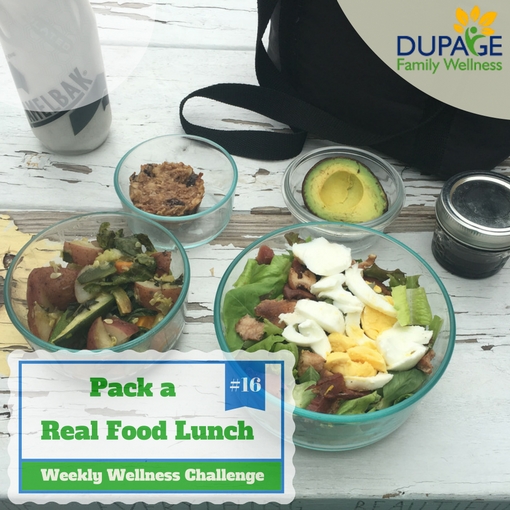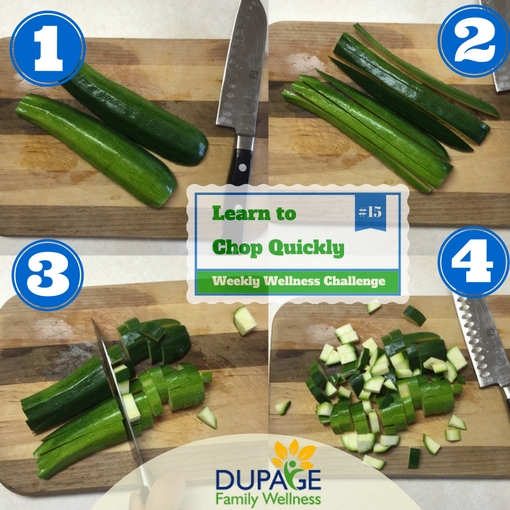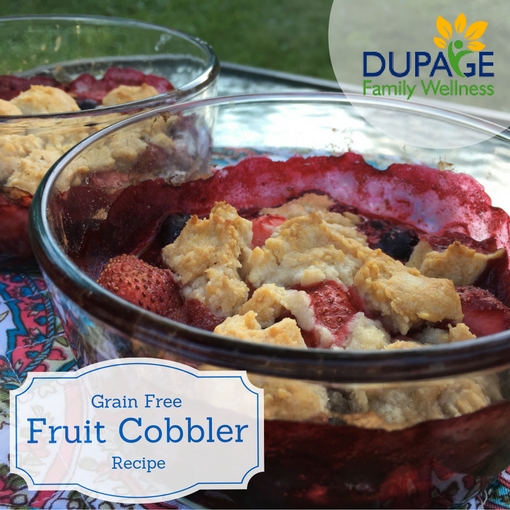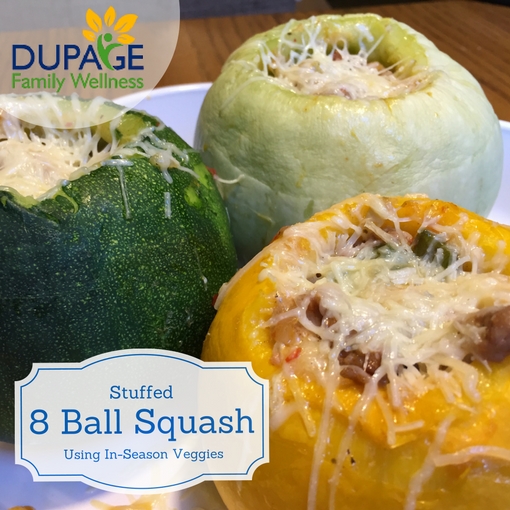 Re-usable water bottle and lunch box that contains salad (with hard boiled egg, bacon, cucumber, tomato, and avocado), container of homemade vinaigrette dressing, hash with potatoes, zucchini, onions and kale, and a homemade chocolate chip muffin
Re-usable water bottle and lunch box that contains salad (with hard boiled egg, bacon, cucumber, tomato, and avocado), container of homemade vinaigrette dressing, hash with potatoes, zucchini, onions and kale, and a homemade chocolate chip muffin
Pack a Lunch that Keeps You Full and Focused All Afternoon
This week I was chatting with a teacher friend who said "It's only 3 weeks into the school year, and I'm already tired of my lunch . Help!".
Focus on nutrient-dense, REAL foods!
Fill lunch boxes with quality fats and proteins to maintain energy all afternoon. Resist the temptation to pack typical lunch foods that are refined and processed (i.e. bread, crackers, chips, cookies, pop, juice boxes, candy, etc). These convenient foods might be easy to grab and stick in the lunch box, but the high sugar and carbohydrate levels cause blood sugar to spike after lunch. When it crashes down, it can cause you to lose energy. You will be ready for a nap before the afternoon is over On the other hand, a lunch with fat and protein keeps blood sugar even, making you feel satisfied and engaged all afternoon.
Eat leftover dinner for lunch
Think about lunch when you make a delicious dinner. Make extra, and remind yourself that you'll have a good lunch if you don't eat it all. We put the leftovers into grab-and-go glass containers when cleaning up the dinner. In the morning, just pop the leftovers into your lunch box.
Nutritious lunch box ideas:
- Wrap a nitrate/nitrite-free lunch meat (Applegate Farms) around slices of avocado
- Breadless sandwiches! Check out these ideas for 15 breadless sandwiches: no bread sandwich ideas
- Homemade soup or leftovers in a thermos
- Chicken, tuna, or egg salad made with homemade mayo
- Salad with homemade oil and vinegar or ranch dressing (easy to make from homemade mayo)
- Guacamole with veggies
- Hard-boiled eggs
- Lettuce Wraps
- Handful of nuts
- Unsweetened dried fruit
- Homemade muffins (Freeze well) – These are a few favorites: cornbread muffins and banana muffins
- Good quality cheese, preferably from pastured cows
- Unsweetened, Plain, Full Fat Yogurt or kefir (try making your own yogurt)
- Apple or celery w/ nut butter
- Unsweetened applesauce - This is easy to make: crockpot applesauce
- Beef Jerky (make your own if you have a dehydrator!)
- Smoked salmon
- Homemade fruit snacks
- Coconut bombs
Having trouble imagining how to make these ideas into a lunch. Pick several items and pack them together for a lunch that will keep you satisfied until dinner.
Our favorite real food lunch combinations:
- Leftover dinner and a piece of fruit
- Chicken salad, celery with nut butter, and a few slices of high-quality cheese
- Two Hard boiled eggs, cornbread muffins smeared with real butter, and a mashed avocado (guacamole) with bell pepper slices
- Homemade soup in a thermos with plain yogurt topped with blueberries, nuts, and cinnamon
- Lettuce wraps with ham, cheese, and avocado slices, a handful of nuts with unsweetened dried fruit (easy trail mix), and applesauce
Remember that transitioning to a real food diet may not happen overnight.
If you aren’t ready to make your own mayo and ranch dressing, it's OK! Just keep moving toward eating more real foods and less packaged, processed, corporation-made "food". Many of the “modern convenience foods” that we buy automatically aren’t that difficult to make on your own. The real ingredients that you use at home are much better for you than the ingredients used in the processed foods in the middle aisles of grocery stores!
A couple of tips to help:
• Set aside a couple of hours each week to prep lunch items (i.e. cut veggies, make a big batch of soup or chicken salad, make and freeze muffins, etc) will make it easy when trying to get everyone out the door in the morning!
• If you have kids, encourage them to help choose, make, and pack their own lunch!
Your challenge this week is to try some of these ideas to make yourself a real food lunch. Let us know how it goes on Facebook.
Joelle Kurczodyna, NTP
Our Two Favorite Techniques for Cutting Vegetables
We realize that eating a real, whole food diet, void of convenience processed stuff, takes some time. Yes, it is easier to unwrap a pre-made pan of lasagna than it is to make it from scratch. Remember that the health benefits of eating real food far outweigh the time saved by the convenience of their processed counterparts. I love this short video by author and journalist, Michael Pollan that explains why homemade is better than corporation made.
Fruits and vegetables are important ingredients in most real food recipes. Learning to cut quickly is a key skill.
Chop or Dice Vegetables Quickly by Hand
Learning to chop veggies was a game changer. When I first started to eat more vegetables (usually 8+ servings a day), I was a SLOW chopper, so making a meal took forever. Once I learned this simple trick, chopping was so much faster. Follow these easy steps to chop any circular vegetable (onion, zucchini, carrot, eggplant, mushroom, etc):
- Make your first cut a cut in half long ways. and place the 2 flat sides down. Then the food doesn't roll away from you!
- Make quick slices in one direction (lenthwise).
- Slice in the other direction, across all the strips, as thin or thick as you need.
- Voila! You you have chopped or diced veggies.
Use a good sharp chopping knife! Don't be afraid of the big knife like the one pictured here. It makes the job easier! The more you chop, the faster you get!
Shred or Slice in the Food Processor
Dusting off the food processor might feel like a lot of work, but this tool can save you time. This is especially true when you are bulk cooking. Yesterday, I made a zucchini and eggplant lasagna. Using the slicer attachment, I had the veggies uniformly sliced in no time. I then switched to the shredder attachment. In less than 2 minutes, I shredded cauliflower into “cauli-rice” to go in a stir fry for another meal. This also works well for slicing vegetables to roast or shredding vegetables for many recipes, including egg casseroles.
Weekly Wellness Challenge
This week we challenge you to think about your chopping and make changes if necessary. Are you using the right knife? Are there any tools like a food processor that could make the job easier? Don't let the time it takes to prepare "real food" stop you from eating healthy! Try out these tips and let us know how it goes! Any other fruits or veggies you struggle to chop? Chat with us on facebook, and we'll try to come up with a tip for you!
- Dr. Jamie and Joelle

This delicious fruit cobbler has been my go to dessert this summer. It is gluten free, grain free, nut free, and delicious! I love its versatility and have made it with berries, peaches, and apples so far. I also love that it contains only a small amount of honey and is mainly sweetened by the roasted fruit.
This cobbler contains my new favorite grain free baking flour – Otto’s Cassava Flour! I heard a buzz about Otto’s, but it seemed expensive. What does a foodie on a budget do? Ask for it for your birthday to try it out! I was not disappointed!
What is Cassava Flour?
Cassava flour comes from the peeled and baked yuca plant root. The fiber and starch properties of this plant make cassava flour act similar to whole wheat flour in recipes.
Why Use Cassava Flour?
I prefer Cassava flour over whole wheat flour because it contains the additional fiber and nutrients from the yuca plant that are not contained in whole wheat flour. Whole wheat flour is mostly starch, and lacks nutrient density.
Today, most standard wheat flours have been treated and processed in undesirable ways making them often unrecognizable by the body and difficult to digest. Otto’s Cassava Flour is made from a clean, unadulterated source of yuca plants, making it more healthful and easier for the body to digest.
Cassava flour is popular because it can be substituted 1:1 for the regular flour in recipes. I’ve also made chocolate chip cookies and tortillas that you would never know were grain free and gluten free. Almond and coconut flour have different properties, and cannot be subbed 1:1 in traditional recipes.
Although I highly recommend cassava flour for the occasional grain free, sweet treat, it is still something to avoid as an every day part of your diet, as discussed in the previous article on moderation.
Otto's Cassava Flour is the only brand that I have researched and tried, therefore I recommend it. There are other cassava flours out there that may also work well but, but I do not have experience with them.
Grain Free Fruit Cobbler Recipe
Cobbler Filling Ingredients:
- Fruit of choice (6-8 peaches or apples, 3-4 cups of berries)
- 2 tsp of Otto’s Cassava Flour
- 1 tsp lemon juice
- ½ tsp Cinnamon (optional)
- 2 tbsp honey (optional – I usually omit and just enjoy the sweetness from the fruit)
Cobbler Topping Ingredients:
- 1 cup Otto’s Cassava Flour
- ½ tsp baking soda
- ½ tsp salt
- 1/3 cup cold butter (coconut oil or lard work also)
- 1/3 cup water
- 2 tbsp honey
- ½ tsp cinnamon (optional)
Directions:
Preheat oven to 425 degrees
- Make the filling: Mix fruit, 2 tsp of cassava flour, lemon juice and cinnamon and honey if desired in a large bowl until coated. Pour into an 8x8 glass baking dish and place in preheated oven for 10 minutes.
- While fruit filling is cooking make the topping. Mix 1 cup of cassava flour, baking soda, salt and ½ tsp of cinnamon. Using a fork, cut in the butter. Add water and 2 tbsp of honey. Mix until a dough comes together.
- Putting on the filling: Drop small spoonfuls of cobbler topping over the pan evenly. Bake for an additional 15-20 minutes until topping begins to turn golden.
Enjoy!
-Joelle Kurczodyna, NTP
 When I was studying nutrition in college, one of my professors always told us “everything in moderation.” I clung to this well known saying and used it to excuse my occasional (but really more like daily) consumption of sweets and treats. I have since come to believe that this is not the best advice.
When I was studying nutrition in college, one of my professors always told us “everything in moderation.” I clung to this well known saying and used it to excuse my occasional (but really more like daily) consumption of sweets and treats. I have since come to believe that this is not the best advice.
What is Moderation?
Moderation: the avoidance of extremes or excesses
The first problem is that it's there are no "rules" to know what moderation means. Who decides what is extreme or excess? There was a recent study to delve into this concept more. Researchers found that not only was everyone's definition of moderation different, but the more people liked a certain food, the more they considered moderate. They almost always set their definition of what was moderate above the amount that they ate- therefore passing off their own behavior as being moderate.
I really like ice cream- so in my mind when I used to have a bowl of ice cream everyday- I was still under the threshold of eating it "in moderation."
You may have problems even if you can avoid excess.
Several years ago, Dr. Jamie told me this analogy, which has resonated with me. Think about this:
When you are born, you have a cup. Each person’s cup is unique, some very small and others, quite large (based on your genes). The cup represents how much junk (stress, toxins, sugar, etc) that your body can handle before showing external signs of break down. For those with smaller cups, you may notice symptoms beginning from a young age ranging in severity from headaches or digestive issues to more serious chronic disease. For those with larger cups, you may be able to go a long time in life before experiencing any negative side effects from your diet and lifestyle choices.
Although this analogy is simplistic, it illustrates why you may not remain healthy if you consume “everything in moderation” forever.
Once your cup overflows, “everything in moderation” is not good advice. At this point, your body is trying desperately to fix itself, while giving you warning signals that something is not right. If you ignore these signals, every little bit causes more damage to your body. When this happens, taking drastic measures for a time will allow your body to heal, remove the warning signs, and restore health.
I often hear people say, “But I’ve done that my whole life” in regards to eating a certain diet or some other lifestyle habit. This leads to the belief that the diet or lifestyle choice could not possibly be tied to whatever negative symptom they are experiencing. Unfortunately or fortunately, your body works hard to keep you healthy. You can abuse it for quite awhile, depending on the size of your cup, before the signs of damage begin to show. The poor choices we make "in moderation” lead to damaging consequences over time.
What advice would I give instead?
My advice would be to listen to your body. If you experience a negative health symptom, your body is trying to send you a message. Do not ignore these symptoms. Rather, dig deep and reach out to figure out the root cause of the symptom you’re experiencing. It just might be caused by the thing that you are "doing in moderation".
What kind of negative health symptoms could be caused by this "overflowing cup?"
The list is long, but here are a few: constipation, diarrhea, bloating, heart burn, joint pain, arthritis, acne, dry skin, allergies, poor blood sugar control, anxiety, depression, headaches, high cholesterol, asthma, fatigue, brain fog, and many more.
Many people have at least one of these symptoms and live with it thinking it is normal. They either think that there is nothing they can do, or that the only solution is to take medication. What most people don't realize is that diet and lifestyle changes could alleviate their symptoms altogether!
This week we have two challenges for you:
1. Think about what you are doing. Notice when you convince yourself that something is OK because it is "in moderation", when you know it's not a good thing. For many people (myself included), avoiding unhealthy foods altogether is easier then just eating a little.
2. Pay attention to your body. Are you ignoring symptoms? Do you assume your aches and pains or digestive symptoms are normal, or just something have to live with?
Do you have any questions or want to discuss this with us? Simply reply to this email, or head over to our facebook page and comment there!
- Joelle Kurczodyna NTP

Earlier this week, my mom shared a great new farmers market find with me: 8 ball squash! I had never seen them before. Stuffing hollowed vegetables with meat and other veggies is one of my favorite meals. Let's try it with 8 Ball squash!
Ingredients:
- 3 - 8 ball squashes - (if you can't find 8 ball squash, this recipe would work great with zucchini or yellow squash- just cut in half and hollow like a boat. No need to do the boiling for 10 minutes step if you are using a long squash, but start baking it in the oven while the filling is in the pan)
- 1 Onion (chopped)
- 1 Tomato (chopped)
- 1 Sweet Bell Pepper (chopped) (Or use hot peppers if you like it spicy)
- 2/3 pound Italian sausage (or substitute meat of your choice). I used a spicy sausage to give it some good flavor
- 1-2 cloves Garlic (minced)
- Salt and Pepper to taste
- Cheese of choice- 1/2 cup (optional)
- (Optional) Additional veggies (e.g. carrots, sweet potato, celery, mushrooms)
Directions:
- Cut off the top of the squash
- Place squash (cut side down) in about an inch of boiling water and let cook for 10 minutes
- While squash is cooking, brown sausage and saute veggies in a pan
- Hollow out squash. Separate seeds, and add flesh to filling mixture.
- Add half of cheese to filling mixture (optional)
- Spoon filling mixture into hollowed out squash
- Top with other half of cheese
- Bake in oven at 350 for 10 minutes or until cheese is melted
Green Peppers are the bumper crop of our garden this year. Later in the week, I made the same filling, and stuffed 5 peppers. I added a small zucchini and a small pablano pepper instead of the bell pepper. Great way to use some produce that is plentiful or produce that you need to use.
Keep in mind that this recipe is totally flexible! It isn't like baking where ratios are important. If there is a meat, veggie, or type of cheese that you like- use it! I bet it will turn out great! Let us know if you try it- and if you find an awesome combo let us know on Facebook!
Dr. Jamie Thomure
 Re-usable water bottle and lunch box that contains salad (with hard boiled egg, bacon, cucumber, tomato, and avocado), container of homemade vinaigrette dressing, hash with potatoes, zucchini, onions and kale, and a homemade chocolate chip muffin
Re-usable water bottle and lunch box that contains salad (with hard boiled egg, bacon, cucumber, tomato, and avocado), container of homemade vinaigrette dressing, hash with potatoes, zucchini, onions and kale, and a homemade chocolate chip muffin



 When I was studying nutrition in college, one of my professors always told us “everything in moderation.” I clung to this well known saying and used it to excuse my occasional (but really more like daily) consumption of sweets and treats. I have since come to believe that this is not the best advice.
When I was studying nutrition in college, one of my professors always told us “everything in moderation.” I clung to this well known saying and used it to excuse my occasional (but really more like daily) consumption of sweets and treats. I have since come to believe that this is not the best advice.
